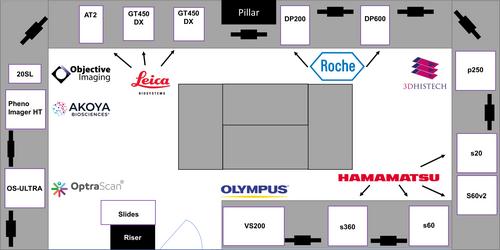Matthew P Humphries, Danny Kaye, Gaby Stankeviciute, Jacob Halliwell, Alexander I Wright, Daljeet Bansal, David Brettle, Darren Treanor
下载PDF
{"title":"开发用于数字病理学人工智能数据采集的多扫描仪设备。","authors":"Matthew P Humphries, Danny Kaye, Gaby Stankeviciute, Jacob Halliwell, Alexander I Wright, Daljeet Bansal, David Brettle, Darren Treanor","doi":"10.1002/path.6326","DOIUrl":null,"url":null,"abstract":"<p>Whole slide imaging (WSI) of pathology glass slides using high-resolution scanners has enabled the large-scale application of artificial intelligence (AI) in pathology, to support the detection and diagnosis of disease, potentially increasing efficiency and accuracy in tissue diagnosis. Despite the promise of AI, it has limitations. ‘Brittleness’ or sensitivity to variation in inputs necessitates that large amounts of data are used for training. AI is often trained on data from different scanners but not usually by replicating the same slide across scanners. The utilisation of multiple WSI instruments to produce digital replicas of the same slides will make more comprehensive datasets and may improve the robustness and generalisability of AI algorithms as well as reduce the overall data requirements of AI training. To this end, the National Pathology Imaging Cooperative (NPIC) has built the AI FORGE (Facilitating Opportunities for Robust Generalisable data Emulation), a unique multi-scanner facility embedded in a clinical site in the NHS to (1) compare scanner performance, (2) replicate digital pathology image datasets across WSI systems, and (3) support the evaluation of clinical AI algorithms. The NPIC AI FORGE currently comprises 15 scanners from nine manufacturers. It can generate approximately 4,000 WSI images per day (approximately 7 TB of image data). This paper describes the process followed to plan and build such a facility. © 2024 The Author(s). <i>The Journal of Pathology</i> published by John Wiley & Sons Ltd on behalf of The Pathological Society of Great Britain and Ireland.</p>","PeriodicalId":232,"journal":{"name":"The Journal of Pathology","volume":"264 1","pages":"80-89"},"PeriodicalIF":5.6000,"publicationDate":"2024-07-10","publicationTypes":"Journal Article","fieldsOfStudy":null,"isOpenAccess":false,"openAccessPdf":"https://onlinelibrary.wiley.com/doi/epdf/10.1002/path.6326","citationCount":"0","resultStr":"{\"title\":\"Development of a multi-scanner facility for data acquisition for digital pathology artificial intelligence\",\"authors\":\"Matthew P Humphries, Danny Kaye, Gaby Stankeviciute, Jacob Halliwell, Alexander I Wright, Daljeet Bansal, David Brettle, Darren Treanor\",\"doi\":\"10.1002/path.6326\",\"DOIUrl\":null,\"url\":null,\"abstract\":\"<p>Whole slide imaging (WSI) of pathology glass slides using high-resolution scanners has enabled the large-scale application of artificial intelligence (AI) in pathology, to support the detection and diagnosis of disease, potentially increasing efficiency and accuracy in tissue diagnosis. Despite the promise of AI, it has limitations. ‘Brittleness’ or sensitivity to variation in inputs necessitates that large amounts of data are used for training. AI is often trained on data from different scanners but not usually by replicating the same slide across scanners. The utilisation of multiple WSI instruments to produce digital replicas of the same slides will make more comprehensive datasets and may improve the robustness and generalisability of AI algorithms as well as reduce the overall data requirements of AI training. To this end, the National Pathology Imaging Cooperative (NPIC) has built the AI FORGE (Facilitating Opportunities for Robust Generalisable data Emulation), a unique multi-scanner facility embedded in a clinical site in the NHS to (1) compare scanner performance, (2) replicate digital pathology image datasets across WSI systems, and (3) support the evaluation of clinical AI algorithms. The NPIC AI FORGE currently comprises 15 scanners from nine manufacturers. It can generate approximately 4,000 WSI images per day (approximately 7 TB of image data). This paper describes the process followed to plan and build such a facility. © 2024 The Author(s). <i>The Journal of Pathology</i> published by John Wiley & Sons Ltd on behalf of The Pathological Society of Great Britain and Ireland.</p>\",\"PeriodicalId\":232,\"journal\":{\"name\":\"The Journal of Pathology\",\"volume\":\"264 1\",\"pages\":\"80-89\"},\"PeriodicalIF\":5.6000,\"publicationDate\":\"2024-07-10\",\"publicationTypes\":\"Journal Article\",\"fieldsOfStudy\":null,\"isOpenAccess\":false,\"openAccessPdf\":\"https://onlinelibrary.wiley.com/doi/epdf/10.1002/path.6326\",\"citationCount\":\"0\",\"resultStr\":null,\"platform\":\"Semanticscholar\",\"paperid\":null,\"PeriodicalName\":\"The Journal of Pathology\",\"FirstCategoryId\":\"3\",\"ListUrlMain\":\"https://onlinelibrary.wiley.com/doi/10.1002/path.6326\",\"RegionNum\":2,\"RegionCategory\":\"医学\",\"ArticlePicture\":[],\"TitleCN\":null,\"AbstractTextCN\":null,\"PMCID\":null,\"EPubDate\":\"\",\"PubModel\":\"\",\"JCR\":\"Q1\",\"JCRName\":\"ONCOLOGY\",\"Score\":null,\"Total\":0}","platform":"Semanticscholar","paperid":null,"PeriodicalName":"The Journal of Pathology","FirstCategoryId":"3","ListUrlMain":"https://onlinelibrary.wiley.com/doi/10.1002/path.6326","RegionNum":2,"RegionCategory":"医学","ArticlePicture":[],"TitleCN":null,"AbstractTextCN":null,"PMCID":null,"EPubDate":"","PubModel":"","JCR":"Q1","JCRName":"ONCOLOGY","Score":null,"Total":0}
引用次数: 0
引用
批量引用


 求助内容:
求助内容: 应助结果提醒方式:
应助结果提醒方式:


